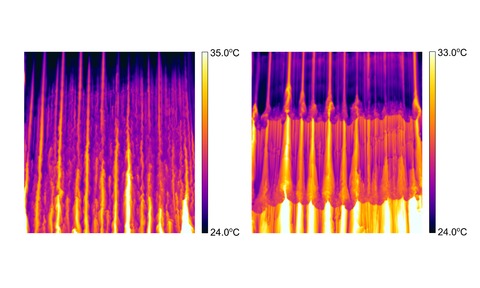
The Department of Chemical Engineering at Imperial College London is using a Flir Systems X6540sc thermal imaging camera to conduct innovative heat transfer experiments.
Studying heat transfer in thin-film flows is the key to enabling the accurate prediction of complex hydrodynamic processes, crucial for the design of many engineering systems that rely on these flows.
Research within the Clean Energy Processes group at the Chemical Engineering Department of Imperial College London is aimed at the development and employment of new imaging techniques for conducting simultaneous spatiotemporal measurements of thickness, velocity, temperature and heat flux in thin-film flows.
Apart from the purely theoretical interest, the high surface-to-volume ratio and small heat and mass transfer resistances of thin films at relatively small flow rates renders them instrumental in the development of efficient means of heat and mass transfer.
Consequently, thin-film flows are employed in a wide variety of engineering/technological applications, such as evaporators, exchangers, absorbers, micro-reactors, thermal management/human support systems in space applications, small-scale electronics-microprocessor cooling schemes, air conditioning and gas turbine blade cooling.
Dr Alexandros Charogiannis, a postdoctoral research associate working under the supervision of Dr Christos Markides, said: “Being able to conduct high resolution (640 x 512 pixel) IR thermography measurements at high frame rates (100 Hz) using the FLIR X6540sc camera will allow us to gain an unprecedented insight into the flow dynamics of a great range of flow regimes of gravity-driven thin film flows, gas-/shear-driven horizontal film flows and Marangoni flows.
“Before purchasing the Flir camera we had to rely on camera loans from the EPSRC Engineering Equipment Pool (EPI) which were dependent on availability. During the evaluation process to select our own thermal imaging camera we looked into 12 different camera options from FLIR and other companies. The results from the demonstration of the X6540sc on our own thin film set-up coupled with FLIR’s strong applications support convinced us that this camera was the optimum component to supplement our experimental setup.”
The X6540sc thermal imaging camera provides ultra-fast frame-rate acquisition for scientific and research applications involving dynamic thermal events.
The device features a 640 × 512 digital InSb detector with spectral sensitivity from 1.5 to 5.5 µm and a f/3 aperture. It provides images up to 125 Hz in full frame and up to 4011 Hz in a 64 × 8 subwindowing mode.
Features on the research grade camera include high thermal sensitivity, snapshot imagery, a motorised spectral filter wheel and a detachable touch-screen LCD.
The camera connects to the company’s ResearchIR Max R&D software for thermal imaging data acquisition, analysis and reporting.
The X6540sc can be temperature-calibrated up to 300°C, or up to 3000°C with spectral and/or neutral density filters, and it provides measurement accuracy of ±1°C for standard configurations.




